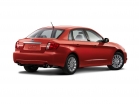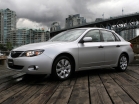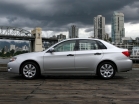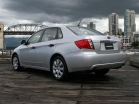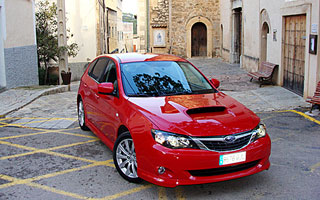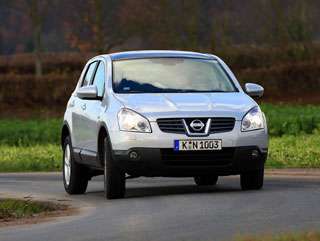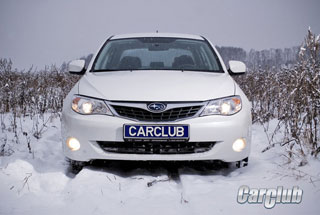Subaru Impreza test drive since 2007 sedan
Test drive updated Subaru Impreza WRX STI from Drom.ru. Come on tougher!
 In 2007, a new generation of Subaru Impreza appeared. Moreover, for the first time this car seemed to the public in the image of a hatchback. Naturally, there was a sedan (but the station wagon disappeared). And everything would be fine, but only the developers decided to release the STI version on the basis of a five -door model. Say, it was better for all kinds of sports requirements than a sedan.
In 2007, a new generation of Subaru Impreza appeared. Moreover, for the first time this car seemed to the public in the image of a hatchback. Naturally, there was a sedan (but the station wagon disappeared). And everything would be fine, but only the developers decided to release the STI version on the basis of a five -door model. Say, it was better for all kinds of sports requirements than a sedan. However, to fans of the brand, the difference between these two types of bodies from the very beginning seemed speculative. Yes, and everyone was used to the fact that it was the STI sedans (well, or the coupe in some cases) tore everyone on sports routes, thereby providing the machine with successful sales and popular love. In other words, the STI hatchback topic from the very beginning seemed to many slightly inferior. And so, in the car of the 2011 model year, under the onslaught of the public, an annoying gap was eliminated.
As a result, we ended up on the Moscow Racing Railway near Moscow in order to get acquainted with the STI sedan who returned to the system with our own hands (and the Christmas, and at the same time evaluate the metamorphoses that occurred with this car after the update.
During the STI hatchback test, I did not leave the feeling that the suspension of this car was not enough final stiffness. That she is a little not led to. Perhaps if I drove mainly for primer or gravel, then the chassis of STI would have seemed rigid, but these cars, despite all the rally genes, are more than 90 percent of cases, are actively operated on the asphalt, and therefore the consumer’s chassis requirements are appropriate .
That is why the pendant revision was not just a refinement. She was specifically fraught. Each stacks were put on a millimeter of the thicker predecessor (21 mm in front and 19 mm behind). Revisions were subjected to the Front steel by 15.6% tougher, and the rear ones by all 53%. The shock absorbers also reconfigured, but for them the exact numbers, the creators of the STI decided not to indicate. Also, the clearance became a little less, it was cut by 5 mm.
The rear subframe received new, more stringent bushings, which positively affected the accuracy and sharpness of the steering. In the front suspension, the rear silent blocks of the lower levers were completely eliminated, replacing ball supports. Despite the fact that the clearance has decreased, the suspension stroke both in front and behind increased. Also, the angles of installation of all wheels were installed.
It is impossible not to say that each wheel assembly dropped 2 kg of unsaved masses lost 8 kg as a result. New wheels are light, from aluminum alloy. You can also optionally order BBS discs, which are unlikely to be heavier than standard ones.
 Another important technical addition (and equally contradictory) was the introduction of an automatic transmission into the STI. This decision seems to me personally contradictory for two reasons. Firstly, I am an opponent of automatic transmission on STI cars (this contradicts their essence). The second, even if you put something automatic in pair to the motor, it should not be a 5-speed box with a hydrotransformer. The same Mitsubishi now offers an EVO X robot with two clutches. Such a box, with the possibility of very fast, almost shock switches, much better corresponds to the explosive nature of the forced pipeline. And here
Another important technical addition (and equally contradictory) was the introduction of an automatic transmission into the STI. This decision seems to me personally contradictory for two reasons. Firstly, I am an opponent of automatic transmission on STI cars (this contradicts their essence). The second, even if you put something automatic in pair to the motor, it should not be a 5-speed box with a hydrotransformer. The same Mitsubishi now offers an EVO X robot with two clutches. Such a box, with the possibility of very fast, almost shock switches, much better corresponds to the explosive nature of the forced pipeline. And here I specially sat down at first precisely in the version with an automaton. So that after mechanics, such a machine does not seem very boring to me. But even so I felt a substitution. And no steering wheel switches will replace full mechanics.
Here, the transfer numbers are longer, which, coupled with the hydrotransformer imposing start and smooth switching, immediately deprives the car with a large handful of pepper (according to the passport in acceleration to a hundred, this STI is 0.8 seconds more slowly). The machine is also on his own mind. Even in manual mode when reaching 6,500 rpm, it switches up. And there is less torque here. To protect the inside of the automatic transmission, the number of Newton meters was reduced by already 57 units (from 407 to 350), and the maximum is available in a very wide speed range from 3,000 to 6000 rpm. By the way, the same box is installed on Tribeca and Outback with a 3.6 -liter engine.
Acceleration is smooth, without explosions, without a sharp closing clutch. He is some kind of fresh. The car, of course, is driving still quickly. But this is clearly not the STI that we are used to. It is enough to stop, open the door and transfer to a sedan with a mechanical gearbox to immediately remember what a real STI should be!
It is such a machine that immediately excites blood, makes you choose your most aggressive driving algorithm. And only the presence of the instructor on the right cools the ardor. An additional machine control body appears with mechanics. Even new suspension settings are felt much better in such a car, although it is already similar to the games of the subconscious.
Indeed, this sedan is much more rigid, sharp and tenacious than the hatchback that I had to travel when the new STI just appeared.
The motor and box for the mechanical version remained unchanged, as well as the accelerated dynamics. The sedan jumps forward sharply in the first gear (which seems very short). Under a clear switch (the lever works like a shutter, and the moment of grasping the clutch is sharp and feels great!) The second and again a dense wave of acceleration presses in the back. At the same time, I feel that thanks to the new suspension, the car squats less on the back during acceleration, and pecks with the nose during gas discharge or sharp braking.
 Yes, and the taxiing has become clearer and more acute, which can be especially good in the refined conditions of the racing highway. And the hard cuts of the Myachkovo allow to make sure that the energy intensity of the suspension inherent in the sports Subaru has not gone anywhere. The chassis only became tougher, but the energy intensity inherent in Subaru was preserved.
Yes, and the taxiing has become clearer and more acute, which can be especially good in the refined conditions of the racing highway. And the hard cuts of the Myachkovo allow to make sure that the energy intensity of the suspension inherent in the sports Subaru has not gone anywhere. The chassis only became tougher, but the energy intensity inherent in Subaru was preserved. The first race in three circles on the machine, the second after the mechanics, and now the time has come to smoke, and at the same time evaluate the appearance of a hot sedan. Well, given the contradiction of the back of the new improvisation as such, we can admit that the STI designers did not work well. Although these headlights, however, we will not go into the subjective.
On the lid of the trunk, a high anti -wing flaunts, and below, along the lower edges of the bumper, double nozzles of the exhaust system are visible. They are now polished and became larger, which undoubtedly added anger. There were also wheels of new design, as mentioned above. There are no more changes in appearance. That it is logical before us is not a restyling product.
Before another series of races, I examine the interior for changes. In general, the interior was left almost in its original form. And besides the new color options, an updated audio system with Bluetooth speaker support can be noted.
The rest of the car with mechanics did not undergo changes. Full -wheel drive with three self -blocks, one of which is active (DCCD) allows a fairly wide limits to adjust the rotation of the car and the capture balance of the front and rear wheels with the road. Si-Drive (a motor control system) helps either save fuel or squeeze everything out of the engine, and with a very sharp reaction to pressing the accelerator. ESP was supplied with a racing mode, and smart ABS is configured for a sports ride.
 But the transmission of an automatic machine is easier. Firstly, there is a free front inter-long differential. Secondly, DCCD systems are absent. The traction between the axes is distributed by a cylindrical asymmetric differential, which blocks the hydraulic coupling with electronic control. The moment is divided into a proportion of 45:55, not 39:61, as on a mechanical version. The back is not Torsen, but a viscous coupling. This set of differences led to the fact that the machine with an automatic machine in marginal modes is less rotary and has a more pronounced insufficient rotation.
But the transmission of an automatic machine is easier. Firstly, there is a free front inter-long differential. Secondly, DCCD systems are absent. The traction between the axes is distributed by a cylindrical asymmetric differential, which blocks the hydraulic coupling with electronic control. The moment is divided into a proportion of 45:55, not 39:61, as on a mechanical version. The back is not Torsen, but a viscous coupling. This set of differences led to the fact that the machine with an automatic machine in marginal modes is less rotary and has a more pronounced insufficient rotation. In addition to the STI, there was a presented and updated inter-sporting WRX with a forced 2.5-liter turbo engine (265 hp and 343 Nm). Now this car is also available in the back of a sedan with stii wings expanded in manner. It should be noted that the WRX sedan was previously present in the model range of the company for the American market, but then a regular narrow body was used. Now the WRX has become wide and got the same diluted on the sides of the double pipes, which will undoubtedly delight its future owners.
Accordingly, here they also conjured above the suspension (the track is expanded by 3 cm in front and 4 from behind). The tires on 17-inch discs are 10 mm wider. The rear subframe, as in the case of STI, received new, more stringent bushings. I devoted the main time of the test precisely STI, so there is nothing special to tell about WRX. It is possible that this car will become the hero of one of our following publications.
Finally, prices. They were also voiced. WRX is estimated at 1,500,000 1,573,000 rubles. The cheapest STI will cost 2 088 600 rubles. This is a hatchback with a machine gun (yes, versions with automatic transmission in the case of STI are cheaper). The most expensive version is estimated at 2,294,000 rubles. This is a sedan with mechanics in the EB version. Sport is now forbid.
Technical characteristics Subaru Impreza Wrx STI
The type of engine is gasoline, four -cylinder, with turbocharged
Working volume (cm3) 2 457
Power (L.S. at rpm) 300/6000 or 300/6200*
Torque (Nm at rpm) 407/4000 or 350/3000-6000*
The drive is complete
Mechanical gearbox 6-speed or 5-speed automatic
Front -type suspension mcpherson with inverted racks
Suspension of the rear independent multi -link
Front ventilated discs brakes
Rear ventilated discs brakes
Length (mm) 4 580
Width (mm) 1 795
Height (mm) 1 470
Wheel base (mm) 2 625
Clearance (mm) 150
Equipped mass (kg) from 1 480 to 1 615 **
Fuel consumption (l per 100 km) 14.1 or 14.8* - city, 8.4 or 8.1* - highway
Maximum speed (km/hour) 255 or 250*
Acceleration to 100 km/h (sec) 5.2 or 6*
The cost of a car in Russia is 1,500,000 2 088 600 rubles
* - For the version with automatic transmission
** - the equipped mass depends on the number of additional equipment installed




Source: Drom.ru
Video Crash tests Subaru Impreza since 2007
Subaru Impreza test drive since 2007
Subaru Impreza crash test since 2007
Krassh Test: Detailed Information84%
Driver and passengers
72%
Pedestrians
73%
Children-passengers
57%
Active security system


